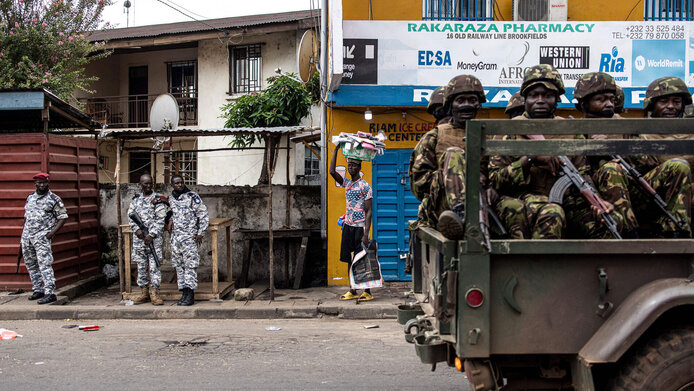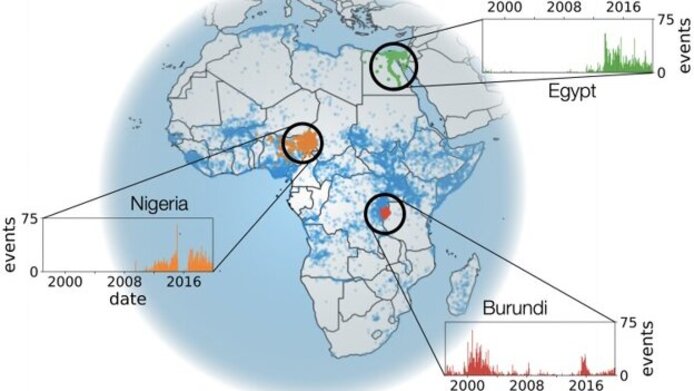Wars under the microscope

A war does not consist of just two armies attacking each other. The chaos of an armed conflict is the result of numerous events involving military forces and civilians – both as victims and perpetrators. Historians habitually looked at these conflicts on a large scale, with all their internal structures, developments and consequences. In recent decades, however, researchers have started to examine conflicts at the level of individual daily events. This perspective has produced large data sets that researchers can use. The attack on a village, an ethnically motivated murder, a family driven from their home or a protest march in the streets of a city thus become jigsaw pieces that enable researchers to gain a better understanding of the big picture.
In this context, researchers often consult the Armed Conflict Location & Event Data Project (ACLED). With the help of local partners, the NGO behind this project registers and checks millions of individual events worldwide, covering periods of several decades. This database also serves as the basis of a research approach by Eddie Lee at the Complexity Science Hub (CSH) Vienna. In a project funded by the Austrian Science Fund FWF, Lee is developing a new way of looking at armed conflicts that makes use of complexity research and network analysis.
One of the Vienna project’s central goals is to enable a better definition and categorization of conflict types. “How do you decide whether something is a war, a civil war, an uprising or another form of conflict, given that the parties involved are always interested in massaging the definition to suit their own interests?” says Lee. “That's why we want to provide the possibility of a systematic definition of conflicts which will facilitate basic research in the social, political and historical sciences.”
Personal details
Eddie Lee studied physics at Cornell University and Princeton University in the USA and was a postdoctoral fellow at the Santa Fe Institute. Focusing on the physics of collective behavior, Lee joined the Complexity Science Hub (CSH) Vienna in 2021.

Long data time series on conflicts in Africa
In a study recently published in the PNAS Nexus journal, Lee and his colleague Niraj Kushwaha at the CSH used their approach to analyze conflicts on the African continent – chosen for the simple reason that the data set for Africa goes back furthest and is the most extensive. The records include roughly 200,000 events between the years 1997 and 2019. The way in which the complexity researchers use this data set aims to deliver valid results despite potential bias in the data.
“No conflict data are completely unbiased and neutral. Our approach has the advantage of being comparatively insensitive to this inherent bias,” explains Lee. “We take a rather coarse-grained view of the data and don't use details about what has supposedly happened. We just extract the fact that a conflict was reported at a particular time in a particular place.”
Using a mathematical method, the researchers have now systematically correlated these data points in order to derive new findings. “These are the central questions: if there are events at one location, are they related to the emergence of further events at another location? On the basis of the emerging patterns, can we conclude with a high degree of certainty that there is a causal link between these events?” explains Lee. “This approach is somewhat reminiscent of the way neurologists study the brain. In their case, however, the events studied are the activity of neurons that also produce patterns together. And neurologists also investigate causal relationships between different brain activities.”
How much does the future know about the past?
Lee’s model is based, inter alia, on the 1940s information theory by the US mathematician Claude Shannon, which takes a very fundamental look at the transmission of messages using statistical methods. “The concept of causality our approach uses is permeated by the question of how information from the past translates into the future,” explains Lee. “In other words, our measure of causality is how much the future knows about the past.”
In one of the findings discussed in the study, the data suggested that events in Sierra Leone were linked to activities in neighboring Liberia. “This was surprising because there are indeed allegations of covert activities by Sierra Leonean soldiers in Liberia,” notes Lee. At the same time, however, the method indicates that certain activities in Sierra Leone, while also suspect, do not appear to be linked to this conflict.
The scale of the relationships found is an important aspect in the assessment. Is one looking at individual events in a local frame of reference or the supra-regional pattern, which is characterized by a large number of events? “Local conflicts are often rooted in larger contexts,” notes Lee. “So the idea is to be able to switch between different levels to see how they interact and what ultimately drives the conflicts. You can think of the principle as a kind of microscope that allows you to look deeply into the turmoil of a war.”
An avalanche of violence
A “mesoscale” view, i.e. a medium zoom level of viewing the conflict web, has proven to be particularly meaningful. It relates to chains of events that take place within days, weeks or months on a geographical scale of a few hundred kilometers at most. Significant cascade effects can be observed in the spread of conflicts. It can be seen, for example, that acts of violence can spread from an epicenter like an avalanche.
While it would seem conceivable to apply a calculation model of this kind to current conflicts such as the war in Ukraine or the war in the Middle East, Lee dismisses the notion. “What we are doing here is basic research. We want to help classify conflicts better in the future and find out, for example, what types of civil wars exist,” he explains. “Looking at current conflicts, which by their very nature are polarizing, could detract from this objective.”
In the context of the ESPRIT program of the Austrian Science Fund FWF, Eddie Lee's research on “Scale behavior and micromechanisms of armed conflicts” carries an amount of EUR 298,000 in funding.
Publications
Kushwaha N., Lee E. D.: Discovering the mesoscale for chains of conflict, in: PNAS Nexus, Vol. 2/7 2023
Lee E. D., Daniels B. C. et al.: Scaling theory of armed-conflict avalanches, in Physical Review 2020





